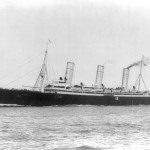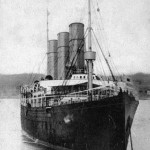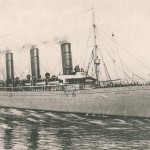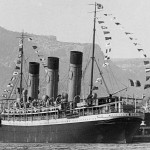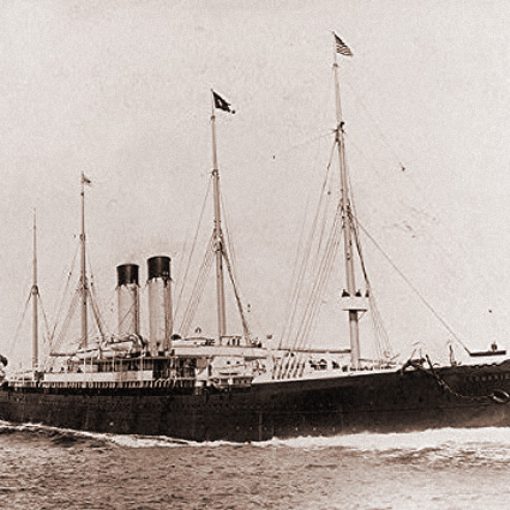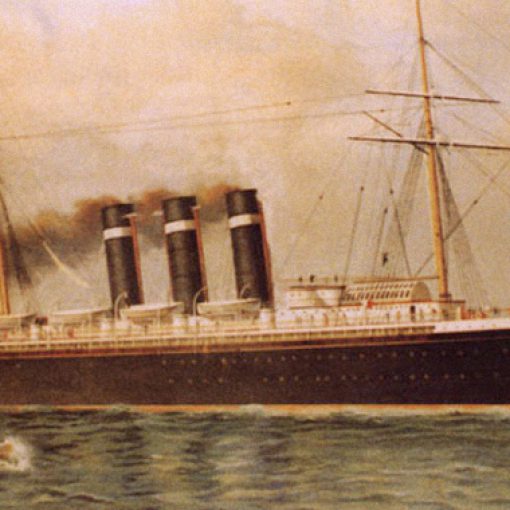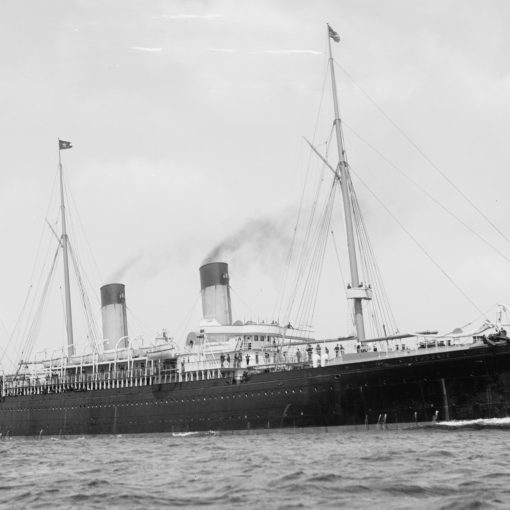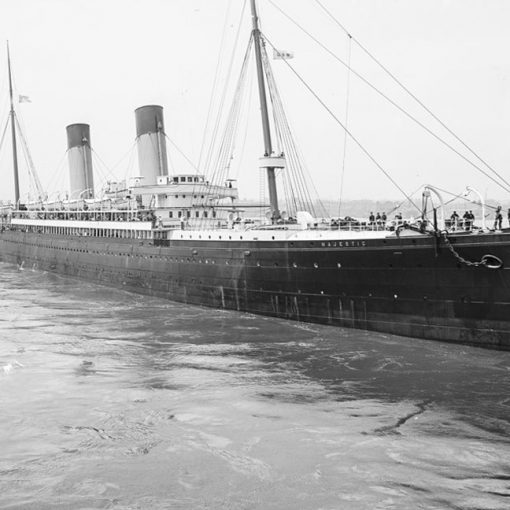1898 – 1916
Also known as Burdigala
By 1895, the largest, fastest and most popular ocean liners were British. The largest ship ever built was the scrapped 19,000 gross ton large Great Eastern, while the fastest ships were the Cunard Line’s Campania and Lucania. These two ships were also the largest ships in existence. With Britain stealing all the glory, the newly formed German state wanted to create a fleet of merchant ships to rival the dominating British.
Germany’s first step to gain popularity on the North Atlantic came when Norddeutscher Lloyd commissioned the 14,000 gross ton Kaiser Wilhelm der Grosse in 1897. The success was immediate. The new liner not only eclipsed the Campania and Lucania’s size, she also beat their best average crossing over the Atlantic, thereby receiving the Blue Riband. It was the first time a German ship ever received this honour. The Kaiser Wilhelm der Grosse was also the most luxurious vessel on the oceans, quickly making her into one of the most popular ocean liners on the North Atlantic. Her four funnels had set the pattern for many future ships to come, and within short a running mate was planned.
On October 5, 1897, only a little bit more than two weeks after the Kaiser Wilhelm der Grosse’s maiden voyage across the Atlantic, the fleet mate was launched from the Schichau shipbuilding company in Danzig. She was to be called Kaiser Friedrich, and she would be approximately 12,300 gross tons large – some 2,000 gross tons smaller than the Kaiser Wilhelm der Grosse. The engines were quadruple expansion ones compared to the older running mates’ triple expansion engines. The machinery would give the Kaiser Friedrich 28,000 Indicated Horse Power. The Kaiser Wilhelm der Grosse had 31,000, in comparison. The Kaiser Friedrich was supposed to have a service speed of 22 knots to blend in as part of the team of the world’s largest liners.
The construction of the Kaiser Friedrich continued until May 12, 1898, when she was completed. During the trials of the ship, it was discovered that she was far from able to maintain the required 22-knot service speed. At best, she reached 20 knots. Norddeutscher Lloyd refused to accept her from the shipyard. However, Schichau guaranteed success anyway and NDL put her into service at last. The Kaiser Friedrich’s maiden voyage started from Bremerhaven on June 7, 1898. Her goal was New York. But as the liner performed very poorly – she never exceeded 20 knots during the entire round trip – she was sent back to her builders after she had returned to Bremerhaven.
After three months of reconstruction, the Kaiser Friedrich was once again delivered to Norddeutscher Lloyd on September 4. She made three voyages to New York for them, but as the speed had not improved noticeably, she was sent back to the shipyard again. After several months of further reconstruction – including the lengthening of each of the three funnels by 14½ feet – the Kaiser Friedrich was taken back on trials for NDL. But the shipyard’s efforts did not pay off; the liner only managed 20 knots, and no more. In June 1899, Norddeutscher Lloyd finally returned the ship to Schichau. This affair became an internationally observed scandal, and the two parts went to court, ending up with the defeat of Norddeutscher Lloyd.
The Norddeutscher Lloyd’s German rivals, the Hamburg Amerika Linie, had observed the proceedings, and decided they wanted to charter the Kaiser Friedrich to see if she was worth sailing. On October 1, 1899, she made her first sailing for HAPAG from Hamburg to New York. Twelve months later, the Kaiser Friedrich was returned to Schichau after ten completed round trips for the Hamburg Amerika Linie. The vessel was then laid up in Hamburg.
The Norddeutscher Lloyd had failed in creating a worthy running mate to the Kaiser Wilhelm der Grosse. After they had realised that the Kaiser Friedrich was not going to follow in her older fleet mate’s wake, the company ordered another vessel to match the first Kaiser with. After several delays, in 1901, the Vulcan Shipyard in Stettin delivered the Kronprinz Wilhelm. But since the order had taken such a long time, the rival HAPAG had managed to build a record breaker of their own. Before the Kronprinz Wilhelm entered service in the autumn of 1901, the Hamburg Amerika liner Deutschland had already snatched the Blue Riband from the Kaiser Wilhelm der Grosse.
As the Norddeutscher Lloyd saw no apparent use for the Kaiser Friedrich, she remained laid up where she was for many years. Not until 1912 did someone express interest of her. The newly formed French Compagnie Sudatlantique in Bordeaux wished to buy her and did so on May 1, the same year. Before the actual take-over, she was sent to Blohm & Voss where she would go through a thorough refit, which included the installation of new boilers. After the refit, the ship was renamed Burdigala. Her first voyage from Bordeaux to South America started on October 5, that year. She continued for little more than a year on this route, when she was laid up in Bordeaux.
When World War I started in 1914, the Burdigala remained laid up for the rest of the year. In March 1915, she entered war-service as an armed transport for the French Navy. On November 14, the following year, the Burdigala was in service in the Mediterranean, in the Aegean Sea between Mykonos and Tenos. Unfortunately, the German U-boat U-73 had laid mines in this area, and the Burdigala hit them and went to the bottom.
The ex-Kaiser Friedrich had been in actual service for less than five years, including her war service. Indeed a fascinating, and very sad, story for a ship that could have been written into history together with ships like the famous Blue Riband holder Kaiser Wilhelm der Grosse – once her near-sister.
Specifications
- 600 feet (183.3 m) long
- 63.9 feet (19.5 m) wide
- 12,481 gross tons
- Quadruple expansion engines powering two propellers
- 19 knot service speed
- Passenger capacity of 1,350 people

